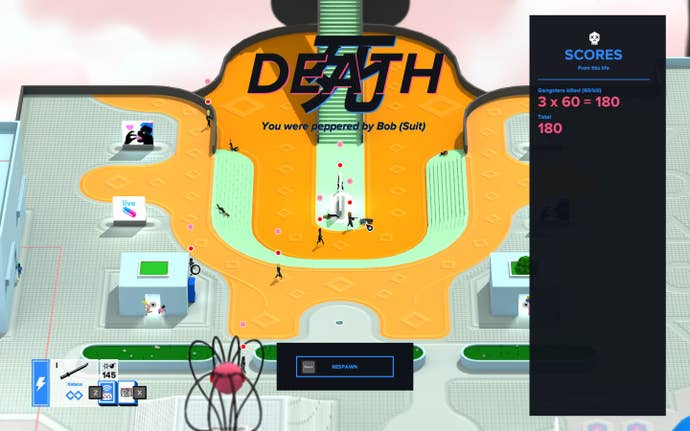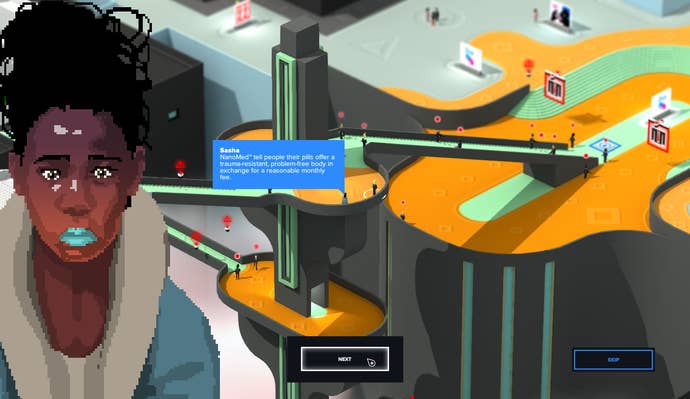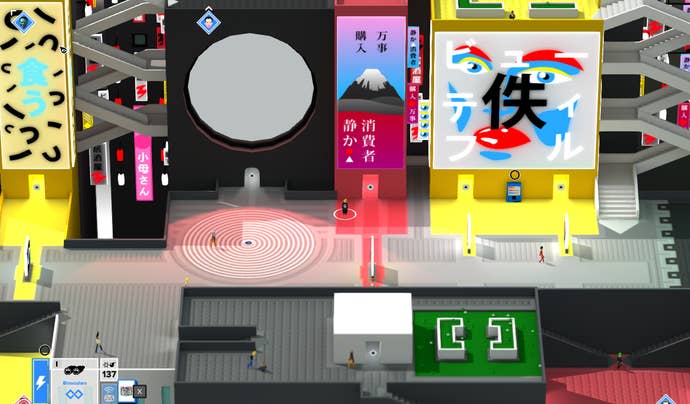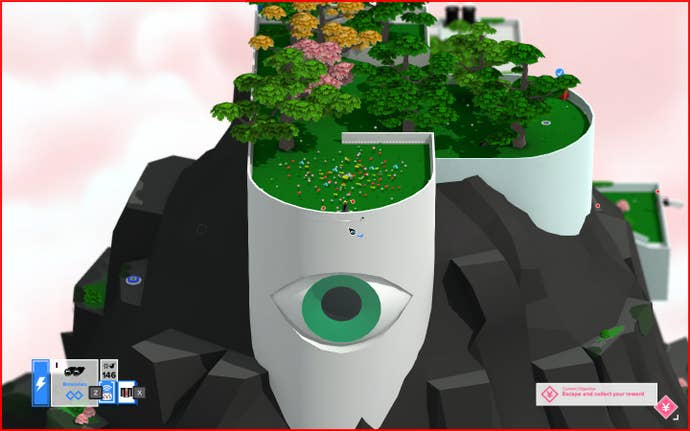Tokyo 42 Review: Assassins Dream of Electric Sheep (and Brutalist Architecture)
Welcome to the cyberpoppunk world of Tokyo 42, where death is an outdated concept. UPDATE: Now, with multiplayer thoughts!
This article first appeared on USgamer, a partner publication of VG247. Some content, such as this article, has been migrated to VG247 for posterity after USgamer's closure - but it has not been edited or further vetted by the VG247 team.
We've updated our Tokyo 42 review with thoughts on our time with the game's multiplayer. You can find the new portion at the bottom.
The first thing we see in Tokyo 42 is a claustrophobic apartment. The type of closet-sized studio akin to what you’d find in San Francisco for $3,000 a month. But the quiet, or as quiet as it gets in a city, doesn’t last for long.
Soon, our identity-shifting hero (I’ll get to that later) gets a panicked call from a friend after seeing something horrible on the news: I’ve been framed for murder (rare in this society, for reasons), and now it’s time to run. The next scene has us running from our complex, police on our tail firing bullets, and then after a dizzying leap off a skyscraper to another rooftop and fleeing to a flying vehicle, we escape. Welcome to Tokyo 42, baby.
There are few games that grab me so effectively, so quickly. Tokyo 42 had me at first pixelated avatar over minimalist cityscapes, it barking typical cyberpunk nonsense into my ear as I waded through a roulette of weapons. Tokyo 42 is an isometric action-shooter from developers SMAC Games. But calling Tokyo 42 cyberpunk does it a disservice, I think, as it belongs more in the realm of cyberpoppunk: something with a lighter, colorful edge to it. Tokyo 42 has a bite to it, sure, as most cyberpunk does. Yet it also isn’t afraid to saturate its world in bright hues, synth-heavy electronic music, more saccharine Brutalist architecture, and beyond.
Tokyo 42 weaves a familiar sci-fi tale, erring on the crutch of “What If Corporations Were, Y’know, Bad?” The backdrop is in a futuristic society where death is fended off by a prescription drug called NanoMed, which is attainable for a low monthly cost. Essentially, people’s livelihoods are tied to the promise of immortality; or as your in-game friend Sasha says, “[NanoMed offers] a trauma-resistant,” (so no murder), “problem-free body.” Even as civilians are accidentally gunned down in the heat of battle, they regenerate in a pink static, only to stand up and run away in fear. Death is an outdated concept in Tokyo 42, reiterated mechanically by the quick respawn upon every bullet that hits you in the game.

As per the set-up surrounding the player character, you’ve been framed for murder. So, naturally, you enter a league of assassins to slowly but surely find out who framed you; essentially killing your way to freedom from a murder you didn’t commit. (Sound logic, am I right?) There are dastardly revelations, betrayals, unlikely partnerships formed. It has all the trappings of the genres that bore it, but all in all, the story is not the focal point in Tokyo 42. Quite literally, it’s everything else.
Tokyo 42 is the type of isometric game where you can change your perspective with only a click (as Fez once did five years ago to spice up the puzzle platformer genre). At a passing glance, it’s reminiscent of the original top-down Grand Theft Auto, the violent repetition of Hotline Miami, and yes, even the calculated perspectives of Fez. But Tokyo 42 shifts into more than that: a nearly perfect open world game for the isometric action genre. It makes its minimalistic world feel just as large and secret-stuffed as any larger title of the genre. But with its fresh perspective, it emboldens everything. Tokyo 42 introduces a city you want to explore endlessly.
Tokyo 42 has some twists on the familiar open world genre. Tokyo 42 favors the now-familiar “play your way” approach: where either guns blazing can be the approach for you, or alternatively, stealth. For stealth, there are miscellaneous tools at your disposal, like a button to change your identity if you get spotted. With your identity constantly altered, the only constant with your player character is the coat on their back, their weapons, and the feline companion they keep. Every round is inevitably a surprise as a building's architecture may lend itself to stealthier opportunities, or not. The playful battles, as bullets coat your screen like a good ol’ bullethell, and different strategies per situation are what makes Tokyo 42 feel surprisingly varied. It’s the marriage of these things that makes Tokyo 42 sing: combining its bright world and brutal gameplay, the type that makes you feel both all-powerful and like the worst player in the world.
Luckily, repetition helps the former. Like Hotline Miami once did, Tokyo 42 is a game where the player dies a lot. But every respawn serves a lesson: was the approach taken the right one? Did I use the right weapon? What are my other options here? A respawn makes you mull over your mistakes, and ensures that you don’t make the same ones again. The respawns are quick too, throwing you right back into the action in the same blink that you left it (the save points usually checkpointed in missions, or at the player’s own behest at designated vending machines—yes, the game leans hard into the Tokyo motif).




Tokyo 42 quickly introduces a grand, colorful city to explore. An open world with secrets to discover, both in the collectable variety (of miscellaneous coats, skins for your cat, and weapon colors) and the “tourism” variety. The tourism secrets are nuggets of easter eggs, like a witch seen performing a ritual from a window on the backend of a skyscraper, or the more mundane, like a person trapped in an elevator. The easter eggs imbue character into the city of Tokyo 42. And despite all the murder and seedy corporations, it’s a pleasant place to spend time.
Tokyo 42 is a dense game, in the well over 20 hours I spent in it. In total, there are 25 main missions to complete, the ones that lead you through the game’s primary story. On top of that, there are nearly 70 side missions, from quests noted by companions, to ones handed out via vending-like machines. There are typical gang-controlled outposts to clear out across the map, freeing up space to explore without the fear of agitated guns on your tail. The missions themselves often alternate between some sort of assassination. Some will have you assassinate targets within a particular time limit. Others are simpler, begging only that you “clear out this particular group.” Sometimes, the mission is a bit unexpected entirely, such as the occasional motorcycle-based quest.
And with the utter of motorcycle, comes some of the game's faults. Driving on motorcycles is often infuriating, with the too-precise controls on a keyboard and mouse battling with having to constantly change the screen’s perspective while driving at lightning speed. On two feet, this is manageable always, because your natural pace is naturally slow, even in a perpetual sprint. On a motorcycle, it's harder to keep up. Some battles, particularly in some of the main missions’ late game content, get frustrating to an intense, rage quitting point. Overcoming the challenges, however, end up being the most satisfying experiences of all. My once-anger often disintegrated as I got more money to buy a new weapon, additional ammo, or a special new coat for my wordless anti-hero.


In most “play your way games,” I stick to one approach. I’m usually the guns blazing type or the alternative (depending on the game, that is). In Tokyo 42, I found myself straying from this typical “one way only” rule I’d adhere to. Instead, I bounced between playstyles frequently. Sometimes depending on the ammo I had in stock, other times on how I felt depending on the location. A faraway building could be prime for sniping; or alternatively, a compact place could make guns blazing the quicker, more practical approach. No matter what, the game always kept me anxious and heavily calculating; one-hit kills sending me only a flashy respawn backwards in time.
Progression comes in reputation you build through the missions you complete, giving you access to more missions in turn. There’s also money: accumulated both via missions scattered throughout the world, and through successfully assassinating a Nemesis before they—gasp—assassinate you first. Luckily, you’re outfitted with a helpful cat companion to track down the Nemesis when the prompt comes up, as they track down and mark the spontaneous villain. This Nemesis system (no, not that nemesis system) adds tension when exploring the world of Tokyo 42—you never know when someone might be right on your tail.

Tokyo 42 wears its influences on its sleeves. There’s references at every turn, to an almost nauseating extent. Your starter coat is named “Deckard.” A building unravels itself to show a room reminiscent of the Black Lodge from Twin Peaks. An achievement you get for completing a motorcycle race is literally named “Redline,” a reference to the stylish anime feature of the same name. And that’s part of Tokyo 42’s inherent fun: a game that wouldn’t exist without the aesthetic, thematic, and game influences that paved the way before it. Tokyo 42 is proud of its influences, and isn’t too shy to drop a name or two in the process.
Above all else, Tokyo 42 was a game I frequently found myself lost in, in the best ways possible. I’d neglect main missions to dig around the map, observing question marks in questionable distances away. I’d accidentally trap myself in the nooks and crannies of towering skyscrapers, and mostly, it would pay off. My curiosity would be awarded with a collectable something awaiting me. I tackled side missions too, oscillating from the mundane to the downright quirky. And by the technical end of Tokyo 42, I still find myself wanting to return to it. With secrets left unchecked in that pause menu, I wouldn’t be surprised if I return to it after all. In the meantime, I don’t see its Beat Vince-composed score exiting my listening rotation anytime soon.

Multiplayer Update, 6/6/2017:
Once upon a time, according to an interview with Edge magazine, Tokyo 42 began as just a simple multiplayer game. When in actuality, it feels vice versa. I'll be honest: matchmaking in Tokyo 42's multiplayer has been pretty rough. Not for connectivity issues, but for the fact that I'm hardly coming across any matches at all. Even nearly a week after launch, I'll boot-up the game and hunt for matches in the three region-centric lobbies, I find nothing in all of them. But a couple times I've lucked out (once in finding a match, another time in beginning a match myself).
It's a shame the matchmaking seems dead most of the time, because the multiplayer component is a delightful blend of everything the game has to offer. In the map, you and others face off in a "Deathmatch," but the name hardly bares the same meaning that you'd see in other multiplayer games. In Tokyo 42's Deathmatch, you're plopped onto a small diorama retaining the impeccable style of the single player's vast open world, but folded into a vertically interesting little cube. Across the diorama are civilians walking around it, as well as weapons, ammo, and more for the player to collect.
The multiplayer mode's biggest strength, much like the single player's, is the stealth. In Deathmatch, you use stealth not to just get away from a foe on your tail, but to blend into your environment. If you don't want to stick out, it's best not to jump around maniacally, or go off the civilians' beaten path. But that also leaves you exposed, should an enemy's cat sniff you out. Luckily, your feline is just as devilish, sometimes escalating to heated firefights between multiple players at once.
The multiplayer is neat in concept, as it's clever to sleuth your way through crowds while trying to discreetly gather all the weapons and ammo you can muster that's littered in hard to reach places. If only there were actually people playing it, so the lobbies wouldn't be a ghost town.
ConclusionOn Tokyo 42's website, the developers boast the game as a beloved blend of Syndicate and Grand Theft Auto, and honestly, they couldn't be more wrong and right. It's both those games in spirit, but twists them into something wholly its own. Tokyo 42 is an isometric cyberpoppunk action-shooter with a city that's worth getting lost in.

